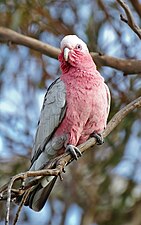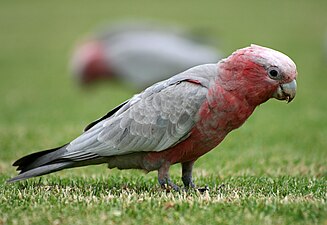Galah
| Galah | |
|---|---|

| |
| male, Adelaide | |
| Scientific classification | |
| Domain: | Eukaryota |
| Kingdom: | Animalia |
| Phylum: | Chordata |
| Class: | Aves |
| Order: | Psittaciformes |
| Family: | Cacatuidae |
| Genus: | Eolophus Bonaparte,1854 |
| Species: | E. roseicapilla
|
| Binomial name | |
| Eolophus roseicapilla (Vieillot,1817)
| |
| Subspecies | |
| |

| |
| Galah range (in red; all-year resident) | |
| Synonyms | |
| |
Thegalah(/ɡəˈlɑː/;Eolophus roseicapilla), less commonly known as thepink and grey cockatooorrose-breasted cockatoo,[2]is an Australian species ofcockatooand the only member of thegenusEolophus.The galah is adapted to a wide variety of modified and unmodified habitats and is one of Australia's most abundant and widespread bird species.[3][4][5]The species isendemicto mainland Australia. It wasintroducedtoTasmania,where it is now widespread, in the mid-19th century[6]and much more recently toNew Zealand.
Etymology[edit]
The term galah is derived fromgilaa,a word from theYuwaalaraayand neighbouringAboriginal languagesspoken in north-westernNew South Wales.[7]
Description[edit]
The galah is about 35 cm (14 in) in length, and weighs 270–350 g (10–12 oz). It has a pale silver to grey back, a pale grey rump, a pink face and breast, and a light pink mobilecrest.It has a bone-coloured beak, and the bare skin of the eye ring iscarunculated.It has grey legs. The sexes appear similar; however, adult birds differ in the colour of theirises;the male has very dark brown (almost black) irises and the female has mid-brown or red irises. Adults are more brightly coloured than juveniles. Juveniles have a greyish breast, crown, and crest, and brown irises with whitish non-carunculated eye rings.[8]
-
male
-
Female (note the reddish iris)
-
A juvenile inSydney
-
female in flight
-
male in flight
Distribution and habitat[edit]
The galah can be found throughout Australia, and is absent only from the driest areas and the far north ofCape York Peninsula.The galah has been introduced to Tasmania through anthropogenic means and there were no sightings prior to 1848.[6]A large population expansion occurred in the 1960s following many escapees from captivity. It is common in metropolitan areas such asAdelaide,Perth,andMelbourne,and abundant in open habitats that offer at least some scattered trees for shelter. It is common in all habitats in its range except for dense forests, especially those with high rainfall.[9]
While it is mostly found in inland areas, the galah is rapidly colonising coastal regions.[9]The changes brought byEuropean settlement,which have been disastrous for many species, have been highly beneficial for the galah, because of the clearing of forests in fertile areas and the provision of stock-watering points in arid zones.
The galah has been introduced to New Zealand.
Classification[edit]
The classification of the galah was difficult. It was separated in themonotypicgenusEolophus,but the further relationships were not clear. Obvious morphological similarities are shared between the galah and the white cockatoos that make up the genusCacatuaand indeed the galah was initially described asCacatua roseicapilla.EarlyDNAstudies allied the galah with thecockatielor placed it close to someCacatuaspecies of completely different appearance. In consequence, the ancestors of the galah, the cockatiel andMajor Mitchell's cockatoowere thought to have diverged from the mainwhite cockatooline at some stage prior to that group's main radiation; this was indeed correct except for the placement of the cockatiel. Ignorance of this fact, however, led to attempts to resolve the evolutionary history and prehistoricbiogeographyof the cockatoos, which ultimately proved fruitless because they were based on invalid assumptions[example needed]to start with.[citation needed]
It fell to the study of Brown & Toft (1999) to compare the previously available data with theirmitochondrial12SrRNAsequenceto resolve the issue. Today, the galah is seen, along with Major Mitchell's cockatoo, as an early divergence from the white cockatoo lineage, which has not completely lost its ability to produce an overall pink (Major Mitchell's) or pink and grey (galah) body plumage, while already being light in colour and non-sexually dimorphic. The significance of these two (and other) characteristics shared by the Cacatuinae had previously been explained away in earlier studies by strict application ofparsimonyon misinterpreted data.
Subspecies[edit]
Threesubspeciesare usually recognised. Slight variation exists in the colours of the plumage and in the extent of thecarunculationof the eye rings among the three subspecies. The south-eastern form,E. r. albiceps,is clearly distinct from the paler-bodiedWestern Australiannominate subspecies,E. r. roseicapilla,although the extent and nature of the central hybrid zone remains undefined. Most pet birds outside Australia are the south-eastern form. The third form,E. r. kuhli,found right across the northern part of the continent, tends to be a little smaller and is distinguished by differences in the shape and colour of the crest, although its status as a valid subspecies is uncertain.
Behaviour[edit]
The galah is often found in flocks of 10 to 1,000 individuals. These can bemixed flocks,the members of which may include Major Mitchell's cockatoo, thelittle corella,and thesulphur-crested cockatoo.The galah readilyhybridizeswith all of these species (see below).[10]Flocks of galahs often congregate and forage on the ground for food in open, grassy areas. Flocks of independent juvenile galahs will often disperse from their birth flock haphazardly. The galah feeds on seeds gathered on the ground, mainly feeding in the morning and late afternoon. Idly, it will strip leaves and bark from trees, and large flocks have been observed to kill trees throughdefoliation.[9]
Breeding[edit]

The galah nests in tree cavities. The eggs are white, usually two to five in a clutch. The eggs are incubated for about 25 days, and the male and female share the incubation. The chicks leave the nest about 49 days after hatching.[11]
Lifespan[edit]
Living in captivity, galahs have been recorded reaching up to 72 years of age[12]when a good-quality diet is strictly followed. They socialise adequately and can engage playfully in entertainment activities to support the overall very intelligent nature of the bird. In their natural habitat, galahs are unlikely to reach the age of 20 years, falling victim to traffic, predators such as thelittle eagleandblackandperegrine falcons,and human activities in some agricultural areas. Like most other cockatoos, galahs create strong, lifelong bonds with their partners.
Hybrids[edit]
The galah readily hybridizes with several species, including the sulphur-crested cockatoo, little corella, Major Mitchell's cockatoo, and the cockatiel. Galah x cockatiel hybrids are often referred to as "galatiels".[13]Aviary-bred hybrids of galah x Major Mitchell's cockatoo have been bred in Sydney, with the tapered wings of the galah and the crest and colours of the Major Mitchell's, as well as the plaintive cry of the latter.
-
A galah ×corellahybrid
-
Young galatiels
Relationship to humans[edit]
In the state ofSouth Australia,galahs are considered "unprotected native fauna" and may be shot (without a permit), trapped or gassed (with a permit) by landowners.[14]
Aviculture[edit]
The galah is very common as acompanion parrotoraviculturalspecimen around the world, although generally absent from Australian aviaries,[15]although permits are available in South Australia to take a limited number of galahs from the wild per year for avicultural purposes.[14]When tame, it can be an affectionate and friendly bird that can learn totalk,as well as mimic other sounds heard in its environment. While it is a noisy bird that may be unsuitable for apartment living, it is comparatively quieter than other cockatoo species. Like most parrots, the galah requires plenty of exercise and play time out of its cage as well as several hours of daily social interaction with humans or other birds in order to thrive in captivity. It may also be prone to obesity if not provided with a suitable, nutritionally-balanced diet.[16]TheWorld Parrot Trustrecommends that captive galahs should be kept in an aviary with a minimum length of 7 metres.[17]
The breeding requirements include the use of upright or tilted logs with a hollow some twenty to thirty centimetres in diameter. Sand and finer grades of wood material are used to construct their nest, the availability ofeucalyptleaves for the nest lining is also suggested for captive breeding.[15]
As food[edit]
The galah has historically been eaten by humans. Galah meat recipes were published in Australian newspapers in the 1930s, alongside jokes about the alleged toughness and unpalatable nature of the bird's flesh.[18][19]
Cultural references[edit]
"Galah" is also derogatory Australian slang, synonymous with "fool", "clown", or "idiot".[20]Because of the bird's distinctive bright pink colour, it is also used for gaudy dress. A detailed description of the Australian slang term can be found in the standup comedy performance ofPaul Hogan,titledStand Up Hoges.Another famous user of the slang "galah" isAlf StewartfromHome and Away,who is often heard saying "Flaming galah!" when he is riled by somebody.
The Australian representative team offootballerswho played a series of test matches ofinternational rules footballagainstIrish sidesin the late 1960s adopted the nickname "The Galahs" after a disparaging reference to their uniform.[21]
Angry Birdsincludes a pink bird named Stella that is intended to be based on a galah.[citation needed]
Namesake[edit]
References[edit]
- ^BirdLife International (2016)."Eolophus roseicapilla".IUCN Red List of Threatened Species.2016:e.T22684758A93045379.doi:10.2305/IUCN.UK.2016-3.RLTS.T22684758A93045379.en.
- ^"Galah (Eolophus roseicapilla) | Parrot Encyclopedia".
- ^Sharland, Michael(1981).A Guide to the Birds of Tasmania.Hobart, Tasmania: Drinkwater.ISBN978-0-949903-03-7.
- ^"Humans to blame for galah problem".20 April 2010.
- ^"eBird: explore species - Galah".18 July 2023.
- ^abGould, Elizabeth; Gould, John; Richter, Henry Constantine (1840).The birds of Australia.London: Printed by R. and J. E. Taylor; pub. by the author.
- ^Dixon et al. (2006): p. 84.
- ^Forshaw (2006). plate 3. "
- ^abcForshaw, Joseph Michael (2006).Parrots of the world: an identification guide.Princeton, N.J.: Princeton University Press.ISBN0-691-09251-6.OCLC57893782.
- ^"Eolophus roseicapilla x Cacatua sanguinea (Galah x Little (Short-billed) Corella (Hybrid)) - Avibase".
- ^Alderton, David(2003).The Ultimate Encyclopedia of Caged and Aviary Birds.London, England: Hermes House. p. 205.ISBN978-1-84309-164-6.
- ^"AnAge entry for Eolophus roseicapilla".The Animal Ageing and Longevity Database.Retrieved22 April2021.
- ^Talking Birds – Australia's Avian Newspaper
- ^ab"Take from the Wild Permits (unprotected)".Department for Environment and Water.Retrieved30 June2022.
- ^abShephard, Mark (1989).Aviculture in Australia: Keeping and Breeding Aviary Birds.Prahran, Victoria: Black Cockatoo Press. pp. 156–7.ISBN978-0-9588106-0-9.
- ^Kalhagen, Alyson."Galah (Rose-Breasted) Cockatoo: Bird Species Profile".The Spruce Pets.Retrieved22 April2021.
- ^"GALAH (Eolophus roseicapilla)".World Parrot Trust.Retrieved22 April2021.
- ^"Galah Grub".The Old Foodie.Retrieved30 June2022.
- ^"Galah Stew".The Recipe Link.Retrieved30 June2022.
- ^"Meanings and origins of Australian words and idioms".Australian National Dictionary Centre.Retrieved11 January2016.
- ^Burke, P., "Harry and the Galahs: Remembering the Meeting of Two Football Codes Thirty Years On",Australian Society for Sports History Bulletin,Vol. 29, (1998), pp. 9–17.[1]
- Brown, D.M. & Toft, C.A. (1999): Molecular systematics and biogeography of the cockatoos (Psittaciformes: Cacatuidae).Auk116(1): 141–157.
- Flegg, Jim (2002):Photographic Field Guide: Birds of Australia.Reed New Holland, Sydney & London.ISBN1-876334-78-9
- Forshaw, Joseph M. & Cooper, William T. (2002):Australian Parrots(3rd ed.). Alexander Editions.ISBN0-9581212-0-6
- Frith, Harold James & Watts, Betty Temple (1984):Birds in the Australian High Country.Angus & Robertson, London.ISBN0-207-14464-8
Cited texts[edit]
- Dixon, R.M.W.; Moore, Bruce; Ramson, W. S.; Thomas, Mandy (2006).Australian Aboriginal Words in English: Their Origin and Meaning(2nd ed.). Oxford: Oxford University Press.ISBN978-0-19-554073-4.
External links[edit]
- The Australian galah:A website dedicated to galahs
- rosakakadu.com Galah-HomepageArchived2018-03-17 at theWayback Machine
- Le Kakatoës Rose,1820s illustration byPaul Louis Oudartand C. Motte.








